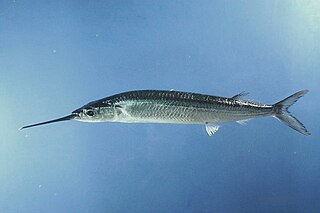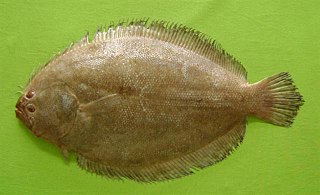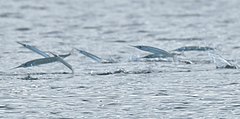
The prickly shark is one of the two species of sharks in the family Echinorhinidae, found in the Pacific Ocean over continental and insular shelves and slopes, and in submarine canyons. Bottom-dwelling in nature, it generally inhabits cool waters 100–650 m (330–2,130 ft) deep, but it also frequently enters shallower water in areas such as Monterey Bay off California. This stocky, dark-colored shark grows up to 4.0 m (13.1 ft) long, with two small dorsal fins positioned far back on its body and no anal fin. It is characterized by a dense covering of thorn-like dermal denticles, hence its common name.

The Australian barracuda, arrow barracuda, Australian sea pike, sea pike, snook, or shortfin barracuda, Sphyraena novaehollandiae, is a barracuda of the genus Sphyraena which occurs in the south-western Pacific Ocean.

The Australian weasel shark is an uncommon species of ground shark in the family Hemigaleidae. It inhabits shallow waters off northern Australia to a depth of 170 m (560 ft); smaller sharks frequent sand and seagrass habitat and shift to coral reefs as they grow older. A slim, drab species reaching a length of 1.1 m (3.6 ft), it has sickle-shaped fins with dark tips on the second dorsal fin and caudal fin upper lobe. Its upper teeth are broad with strong serrations only on the trailing edge. The lateral line along each side is prominent and exhibits a downward curve below the second dorsal fin.

The Kapala stingaree is a species of stingray in the family Urolophidae, endemic to inshore waters off southeastern Queensland and New South Wales. It is commonly found on and around rocky reefs at a depth of 10–130 m (33–427 ft). Reaching 51 cm (20 in) in length, the Kapala stingaree has a rounded, diamond-shaped pectoral fin disc and a slender tail, which ends in a leaf-shaped caudal fin and bears lateral skin folds and a small dorsal fin in front of the stinging spine. It has a distinctive bell-shaped curtain of skin between its nostrils. This species is greenish above, with a highly variable pattern of dark markings usually found outside and between the eyes, and over the back and tail.

The mutton snapper is a species of marine ray-finned fish, a snapper belonging to the family Lutjanidae. It is found in the Western Atlantic Ocean.

The Malabar trevally, also known as the Malabar jack, Malabar kingfish or nakedshield kingfish, is a species of large inshore marine fish of the jack family, Carangidae. It is distributed throughout the Indian and west Pacific Oceans from South Africa in the west to Japan and Australia in the east, inhabiting reefs and sandy bays on the continental shelf. The Malabar trevally is similar to many of the other species in the genus Carangoides, with the number of gill rakers and the grey-brown colour of the tongue being the diagnostic features. The Malabar trevally is a predator, taking a variety of small fish, cephalopods and crustaceans. The species is of minor economic importance throughout its range, caught by a variety of net and handline methods.

The cleftbelly trevally, also known as the cleftbelly kingfish, Kuweh trevally or thin crevalle, is a species of tropical marine fish of the jack family, Carangidae. The species inhabits coastal waters throughout the Indo-West Pacific region from South Africa in the west to Japan in the east, often found near the water's surface. The cleftbelly trevally is the only member of the genus Atropus and is distinguished by a number of anatomical characteristics, with a deep median groove in the belly giving the species its common name. It is not a large fish, growing to a maximum recorded length of 26.5 cm. Cleftbelly trevally are predatory fish, taking a variety of small crustaceans and fish. The species is of minor importance to fisheries throughout its range.

The coastal trevally, also known as the onion trevally, Japanese trevally or bluefin kingfish, is a species of inshore marine fish in the jack family Carangidae. The species is distributed throughout the tropical and subtropical waters of the Indian and west Pacific Oceans, from South Africa in the west to Japan and New Caledonia in the east, reaching as far south as Australia. The species is found on deep coastal reefs, both in schools and as solitary individuals, where they prey on small midwater organisms including crustaceans, small fish and cephalopods. The species is taken as bycatch in a number of fisheries throughout its range by a number of fishing methods and is of little commercial value, but is considered to be a good table fish. A mistype in the original volume in which Eduard Rüppell named the species led to the combination Carangoides caeruleopinnatus, which has incorrectly spread through the literature.

The shadow trevally, also known as the shadow kingfish, twothread trevally or Aldabra trevally, is a species of inshore marine fish in the jack family Carangidae. The species is patchily distributed throughout the tropical and subtropical waters of the Indian and west Pacific Oceans, from South Africa in the west to Japan and Samoa in the east, reaching as far south as Indonesia and New Caledonia. It is most easily distinguished from similar species by as series of dark rectangular blotches under the second dorsal fin, giving a 'shadowed' appearance, from which its common name is derived. The shadow trevally is a reasonably large fish, growing to 85 cm in length and at least 2.6 kg in weight. It inhabits shallow coastal waters, including reefs, bays, and estuaries, where it takes small fish and benthic crustaceans as prey. Nothing is known of the species' ecology and reproductive biology. It is of little importance to fisheries, and is occasionally taken by bottom trawls and other artisanal fishing gear.

The barcheek trevally, also known as the barcheek kingfish, shortridge trevally or oblique-banded trevally, is a species of moderately large marine fish of the jack family Carangidae. The barcheek trevally is distributed throughout the tropical waters of the Indo-west Pacific region, ranging from South Africa in the west to Japan, Australia and a number of small central Pacific islands in the east. The species inhabits inshore and offshore waters, found along the slopes of lagoons and out to deeper reefs on the continental shelf, where it preys on small fish and benthic crustaceans. It is a moderately large fish, growing to a maximum recorded length of 50 cm, and can be distinguished from similar species by its somewhat protruding lower jaw and the dark banding on its operculum. It is of minor importance to fisheries throughout its range, taken by trawling, hook and line methods and various inshore fish netting methods.

The Senegal jack, also known as the African jack, is a species of large marine fish classified in the jack family Carangidae. The species is distributed through the tropical waters of the eastern Atlantic Ocean, ranging along the west African coast from Angola in the south to Mauritania in the north. It can be distinguished from co-occurring relatives by its longer dorsal fin lobe, as well as a host of other anatomical features. The Senegal jack grows to a known maximum length of 1 m. It is a coastal species, known to live semi-pelagically, inhabiting both the sea floor and surface waters to depths of around 200 m. The Senegal jack is a predatory species, taking fish, crabs and shrimps as its main prey items. The species reaches sexual maturity at 21 cm in females and 24 cm in males, with spawning occurring in two periods; February to April and September to November. The species is of minor importance to fisheries, and is not discriminated from other jacks in catch statistics. It is taken by trawls, seines and hook and line, and sold fresh or preserved.

The torpedo scad, also known as the hardtail scad, finny scad, finletted mackerel scad or cordyla scad, is a species of moderately large marine fish classified in the jack and horse mackerel family, Carangidae. The torpedo scad is distributed throughout the tropical Indo-Pacific region, ranging from South Africa in the west to Tonga in the east, extending to Japan in the north and Australia in south. It is a schooling pelagic fish which occupies the surface layers of both inshore and offshore oceanic waters. The torpedo scad is easily identified by both its 'torpedo' shaped body and a series of detached finlets at the rear of both the dorsal and anal fins. The largest recorded individual was 80 cm long and weighed 4 kg, although it is more common at lengths less than 40 cm. It is a predatory species, taking a variety of fish, cephalopods and crustaceans by both active and filter feeding. There is a shift in diet as the species grow; however fish is the dominant prey in all size classes. Torpedo scad reach sexual maturity at 22 cm in females and 26.4 cm in males, with spawning occurring between March and July in India, where significant research into larval growth and morphometrics has been carried out.

The king threadfin, also known as the blind salmon, blink tassel-fish, burnett salmon, gold threadfin, king salmon, kingfish, Sheridan threadfin, triped tassel fish, or threadfin salmon, is a species of marine ray-finned fish, a threadfin from the family Polynemidae which is found in southern New Guinea and northern Australia.

The longrakered trevally, also known as the cale cale trevally and heavyjawed kingfish, is a species of marine fish in the jack and horse mackerel family Carangidae. The longrakered trevally is distributed throughout the tropical and subtropical waters of the Indian and west Pacific Oceans, from Mozambique and Madagascar in the west, to Japan and northern Australia in the east. A large species growing to a recorded length of 1 m, the longrakered trevally is distinguished by is protruding lower jaw, elongated gill rakers and lack of villiform teeth on its tongue. It is an inshore species, restricted to coastal and estuarine regions, where it preys on fishes and crustaceans. Little is known of the species reproductive cycle or growth. The longrakered trevally is of minor importance to fisheries and is often taken as bycatch in finfish and prawn trawls, as well as by recreational fishermen.

The Indian Scad, also known as the Northern mackerel scad, round scad, Russell's mackerel scad, slender scad or the three lined grunter, is a species of ray-finned fish of the genus Decapterus which is part of the family Carangidae and which occurs in the Indian Ocean. It has colonised the eastern Mediterranean through the Suez Canal. It is an important species in coastal fisheries throughout its range.

Sphyraena chrysotaenia, the yellowstripe barracuda, is a species of predatory, ray finned fish from the family Sphyraenidae which is found in the Indo-West Pacific region. It has entered the Mediterranean Sea from the Red Sea through the Suez Canal as a Lessepesian migrant and is now an important species in the fisheries of the eastern Mediterranean.
Hyporhamphus affinis, the tropical halfbeak, tropical garfish, insular halfbeak or coral reef halfbeak, is a species of schooling marine fish from the family Hemiramphidae. It is distributed through the Indo-Pacific regions and has been recorded in the Mediterranean Sea which it reached through the Suez Canal.

Hyporhamphus unifasciatus, the common halfbeak or the Atlantic silverstripe halfbeak, is a bony fish in the family Hemiramphidae. It is found in the subtropical western Atlantic Ocean and the Gulf of Mexico. It is a common fish and not used for food to any great extent, and the International Union for Conservation of Nature has listed its conservation status as being of "least concern".

Pseudorhombus arsius, the largetooth flounder, is a species of left-eyed flatfish, that is the dark side with the eyes on the adult fish is the left side of the fish's body, from the family Paralichthyidae. As Rhombus polyspilos it was named as the type species of the genus Pseudorhombus. It is an Indo-Pacific species and is fished for by both recreational and commercial fisheries.

The silk snapper, the West Indian snapper, yellow-eyed snapper or yellow-eyed red snapper, is a species of marine ray-finned fish, a snapper belonging to the family Lutjanidae. It is found in the Western Atlantic Ocean.



















